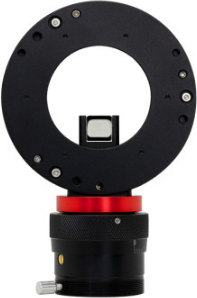Glossary |
Off-Axis-Guider (OAG) |
updated: 2022-10-18 |

With an Off-Axis-Guider (OAG) there's no need for an extra guider scope and are best suited for focal lengths over 1,500mm as longer focal length require a higher guiding accuracy which can only be obtained by using guide scopes with higher focal length making them bulkier.
On the other hand, using main telescopes with shorter focal lengths, OAGsF have the negative effect of "stealing" or blocking some light by deflecting a small portion to the guide camera.
Off-axis guiding has the advantage of eliminating a separate guide scope, thereby avoiding the potential for flexure and reducing load on the mount.
A popular alternative to a guide scope is a modified 50mm finder, particularly if your imaging scope has a focal length less than 1m.
A CDD camera or stand-alone autoguider can be directly attached to the side of the Off-Axis-Guider.
The disadvantages of OAGs are:
- When imaging with a very large chip, the pick-off mirror may eclipse part of the image.OAGs add to the optical path, thus requiring a scope with a greater focuser range.
- Flexure between the main scope and guide scope is mostly eliminated, but may introduced because of the long path of devices attached to the main scope.
- OAGs require that a suitable guide star be visible in the part of the main telescope’s light path
Example: ZWO ASI AOG-L

Read this article about guiding (also using Off-Axis Guiders)
Created with the Personal Edition of HelpNDoc: Effortlessly Convert Your Word Doc to an eBook: A Step-by-Step Guide
